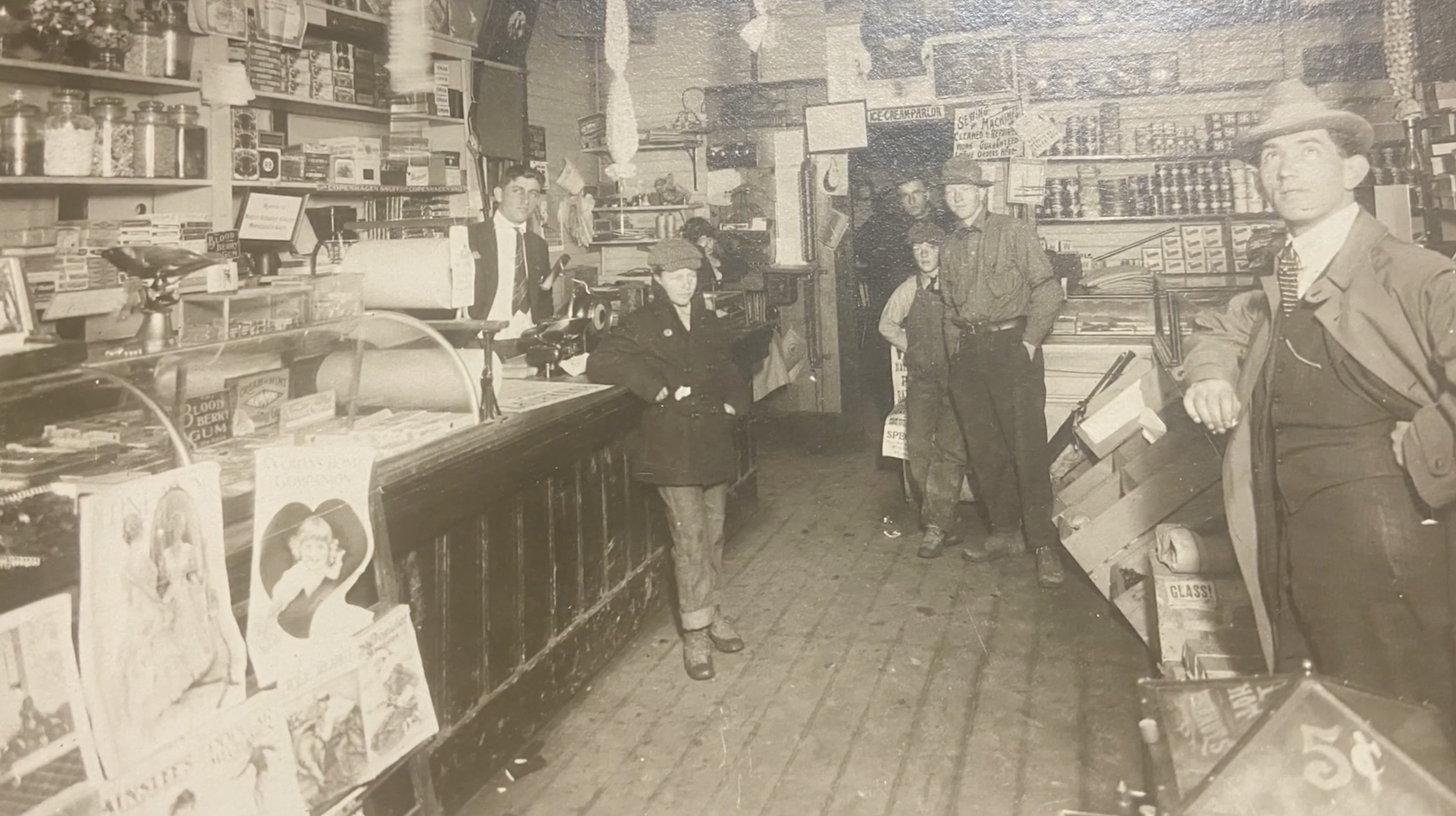Main Street Stroll
A Historic Adventure
in Plymouth, CA
The purpose of the Main Street Stroll Project is to help locals and tourists see the heart and soul of Plymouth, California through a brief history of its buildings on Main Street. Each plaque placed on Main Street in Plymouth, CA, has stories and pictures of the buildings from the past and/or people who were associated with the building.
Funded by Rotary, the Plymouth Foothill Rotary, and the City of Plymouth, plaques are on display at historical old buildings of Main Street in Plymouth, CA.
This self-guided tour is year-round & every day.
Don’t forget your camera!

Roos Building
9486 Main Street,
Plymouth CA
The Roos Store was originally a brick building built in Fiddletown, taken down and brought here with the original wooden beams about 1873 by San Francisco merchants and Wells Fargo agents Rosenwald and Kahn. Their well-known store in San Francisco allowed them to bring a wide variety of goods to Plymouth. The store was considered upscale by many.
The Sanborn Fire Maps of 1890 and 1912 listed that general merchandise was sold here. Warehouses from that time and west of the store and shown on the map are gone. In 1877 a fire badly damaged the store and the wooden portions had to be rebuilt.
In 1911 the store sold to Stan Coblentz, Adam Baer and Gabriel and Moise Roos. One could purchase nearly anything there from colorful dishes to dynamite. The location of the store was both great for business and easy for teams and wagons stacked with lumber and logs to make the turn in front.
Folks could park their rigs near the Leoni Livery and the blacksmith shop then go to the Roos Store to shop. The warehouse was located across the street near the livery.
Sheepherders would bring their sheep there for shearing. The wool would be stuffed into large bags with the men competing to see who could stuff the bags the fullest. The building was remodeled in 1937 and the large iron doors removed.
View Video Below for more Information
Speaker: Audrey Crain-Souza
Plymouth resident
born 5.21.1922
Ms. Souza is a centarian whose family has long rooted
ties to the community.

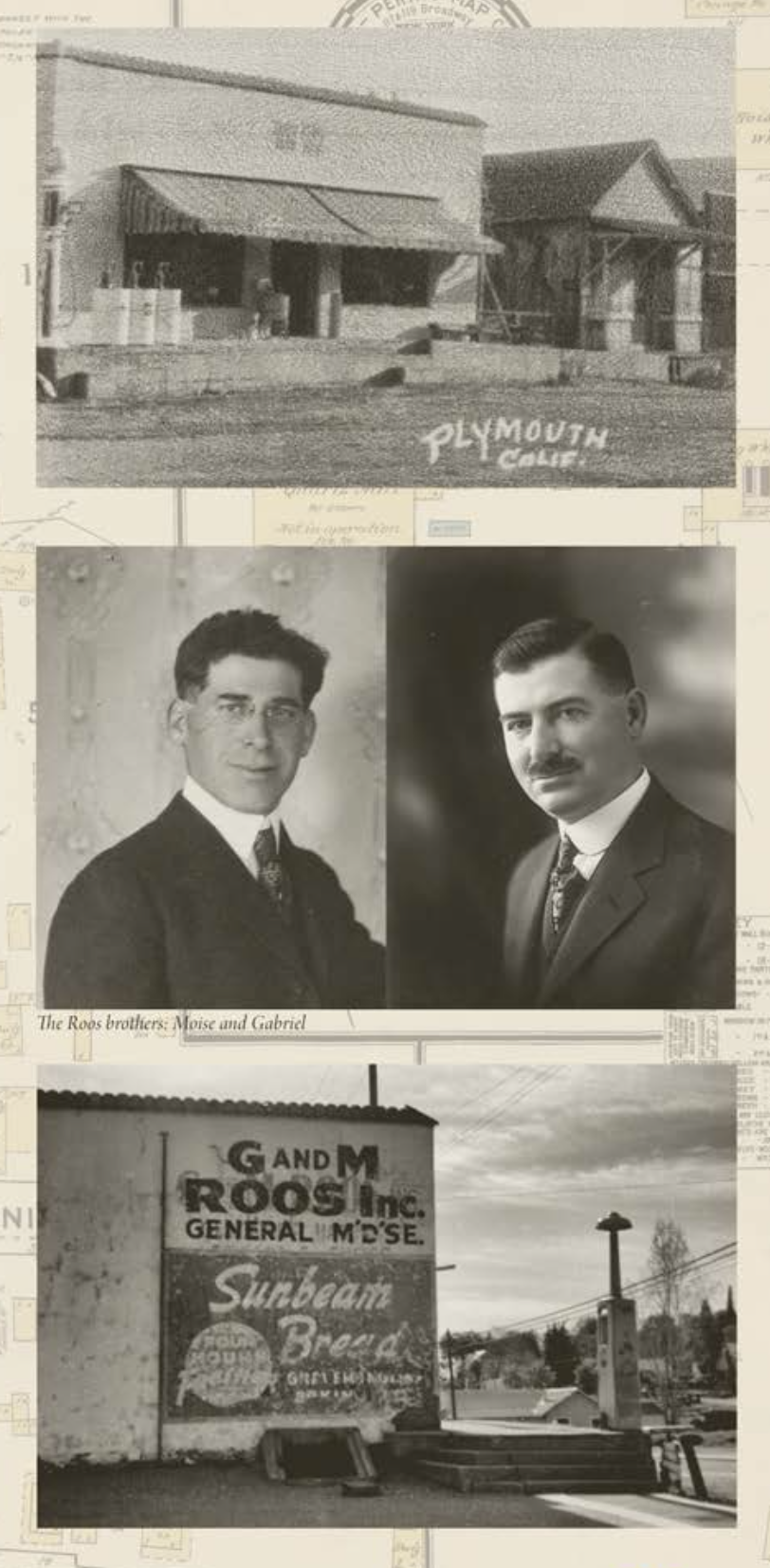
The Levaggi Store
9470 Main Street,
Plymouth, CA
Built in 1857 by Joe Williams who ran this as a general store and used until 1879. It had sand in the ceiling and large iron doors for fire protection. Alvinza Hayward, owner of the Empire Mine bought it for an office and commissary for the Plymouth Consolidated Mine. It was known as the Empire Store and was Plymouth’s first telegraph office.
Hiram Potter an early Plymouth pioneer next had a mercantile from 1892 to 1905. Potter then he sold it to Bernardo Levaggi who named it B. Levaggi General Merchandise. Bernardo was born in Genoa in 1842, immigrated to the U.S. about 1860 and came to Amador County as a miner and business owner. His mercantile was so successful that it became one of the most important in the region. He also operated Levaggi and Co. in San Francisco with his son Jules.
Levaggi sold liquor from eastern distilleries along with house brands: Royal Life Whiskey, High Life, Clermont, and Old Silver Oak. Prohibition ended the alcohol business.
Bernardo’s brother G.B. Levaggi came to California and was successful in selling olive oil. Returning from a trip to Tuscany, he started the Levaggi Import Co. featuring prime olive oil from Lucca, Italy, selling it in California and the U.S.
Immigrants from Lucca knew that the Levaggi brothers would welcome them to Plymouth. Assisting these immigrants, the Levaggi brothers next invested in the Bank of Italy that later became the Bank of America along with the founding of the original Bank of Amador County.
Today it is owned by Bernardo’s great-granddaughter and is California Historical Landmark No. 470.
Speaker – Francesca Levaggi
Plymouth resident – Ms. Levaggi grew up in Plymouth and is the great granddaughter of Bernardo Levaggi.
Click Video Below for more Information
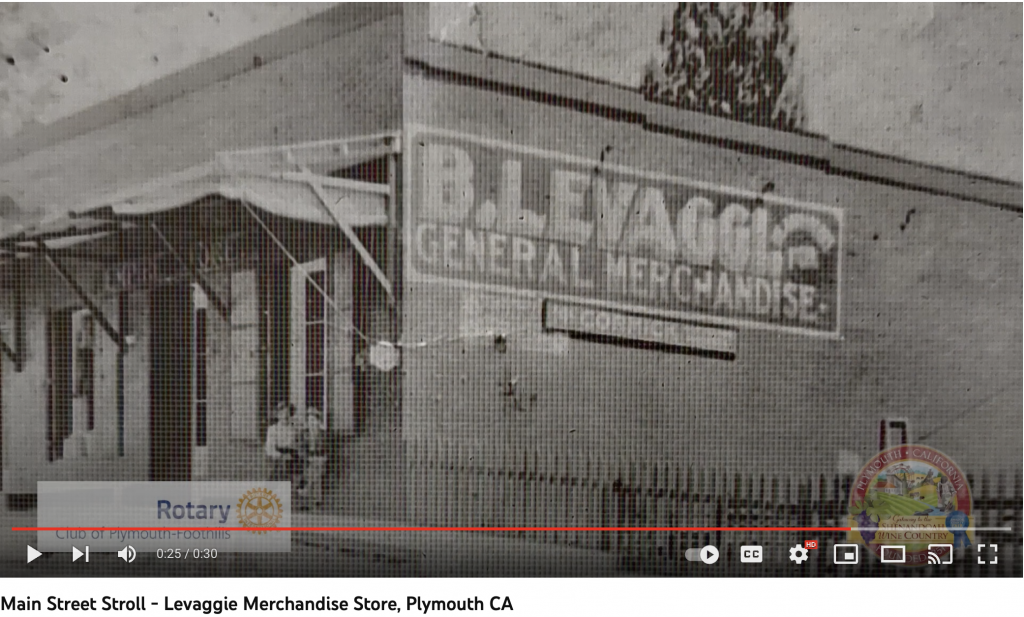

The Bank
9454 Main,
Plymouth, CA
May 1, 1897, Varney Gaskill started the Bank of Amador County in Jackson. In 1915 the bank purchased the lot and constructed this building shortly after. The lot was once part of the Sutherland Quartz Mine.
This bank has an unfortunate legacy of being Amador’s most robbed bank with five robberies since 1936. The photos show the 1974 made-for-TV movie series The Manhunter when the bank was was used to film the first episode in 1973 and depicts a 1930s small town bank in Idaho.
An ad in the October 26, 1906 Amador Ledger urged people to deposit their money in the bank with the line, ”Don’t bury your money; when you die it can’t be found and you are liable to be robbed when you are alive.”
In 1965, the Bank of Amador merged with Wells Fargo Bank, which came to the county in 1855.
Wells Fargo closed its Plymouth branch in May 2020.
Click Video Below for more information.
Speaker: Albert Miller
Albert Miller grew up in Plymouth where his great
grandparents settled in the late 1800s. He maintained
the Plymouth Elementary School, drove generations of
Plymouth school kids to school, served on the city
council, the planning commission, the volunteer fire
Department and coached youth baseball and softball.
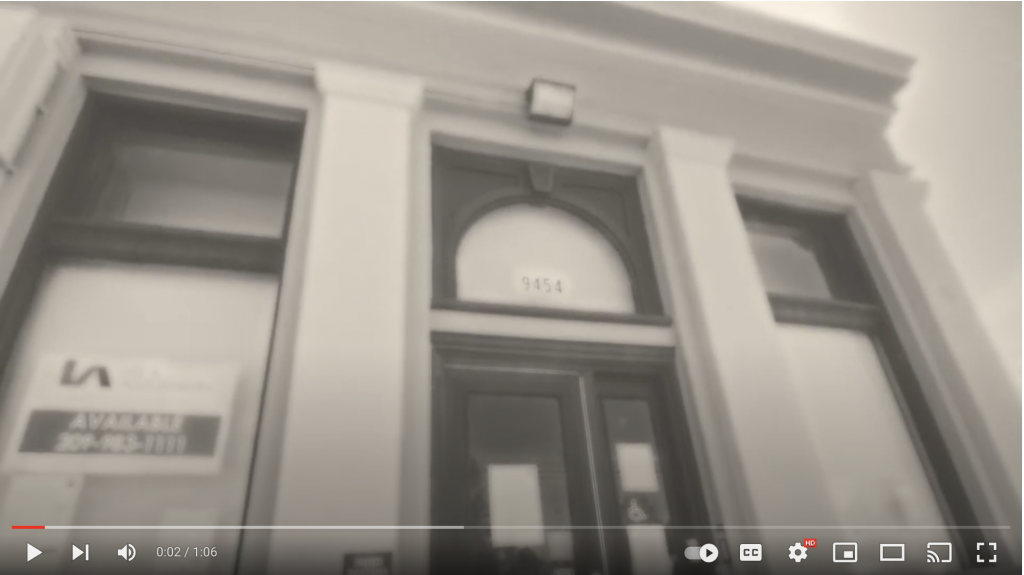
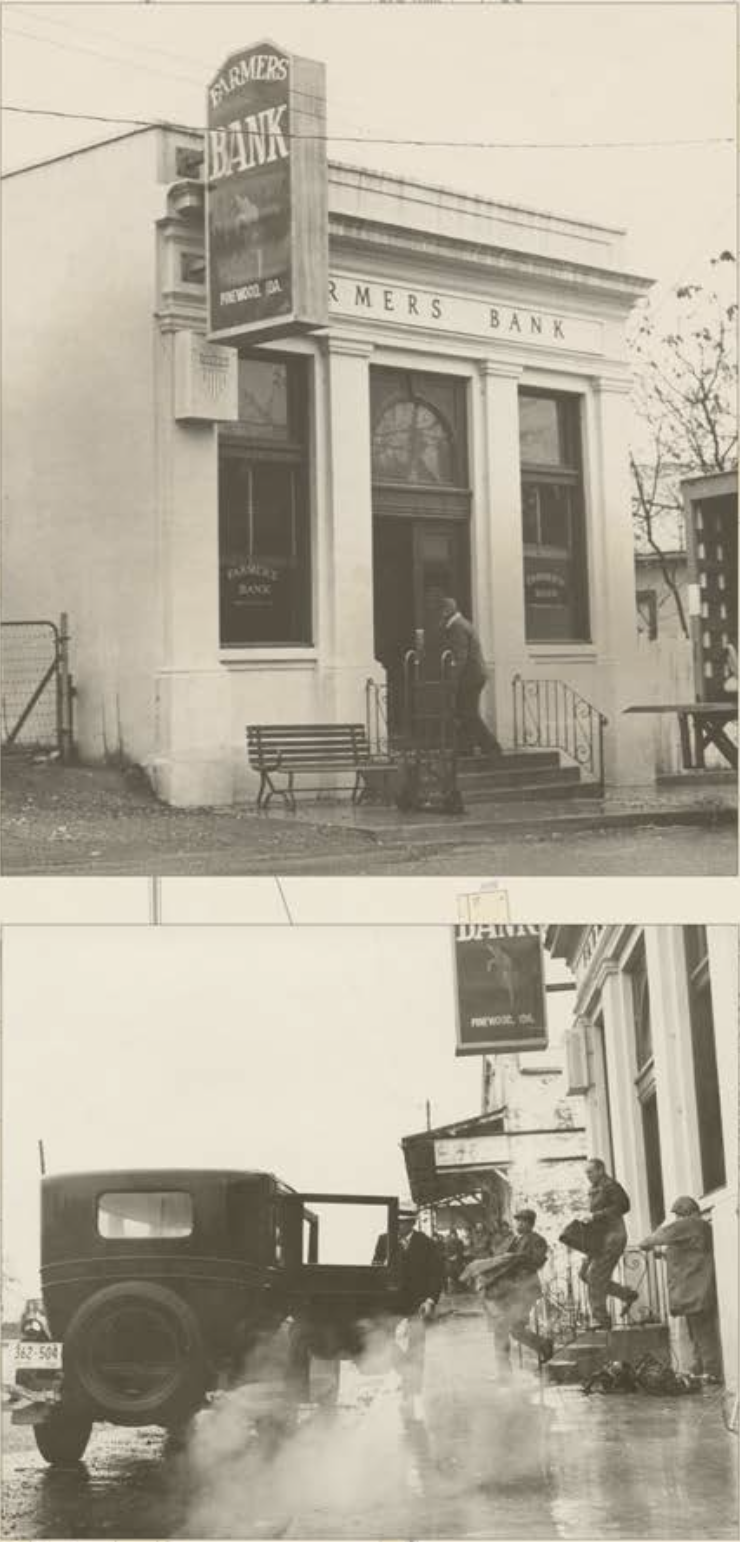
Sakae House/Weston Mortuary
9446 Main, Plymouth CA
This house was owned by Trevor Weston and at one time was one of Plymouth’s mortuaries. According to an article in the September 1931 Amador Ledger, the front of the Weston Mortuary was badly damaged during the big fire and was to be repaired immediately. The vacant lot next door was a barber shop. A business card from the 1939 Gold Rush Days Souvenir Program lists this building as the mortuary as well as a notary public and insurance business. Dr. Robert Claytor had his office here when it became a medical office. His nurse was Thelma Lawarence Anderson whose family had long ties to Plymouth.
Sakae Roberson lived here for years and graced the city with many flowers and plants. Her husband T.J. was the constable of Plymouth.
Today Sakae’s son Seth Roberson and his wife live here and it remains much as it was during its medical and mortuary days.
Click Video below for more information.
Speaker – Seth Roberson
Seth Roberson and his wife, Jan currently live in the
House once owned by his mother who contributed to the
aesthetics of the city and his father who, as constable
contributed to the safety of the City.
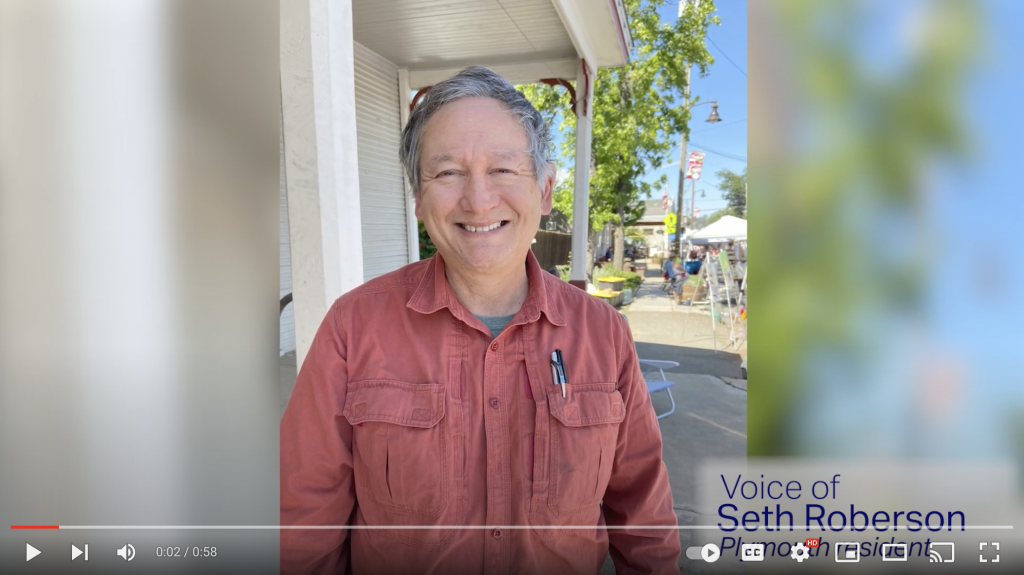
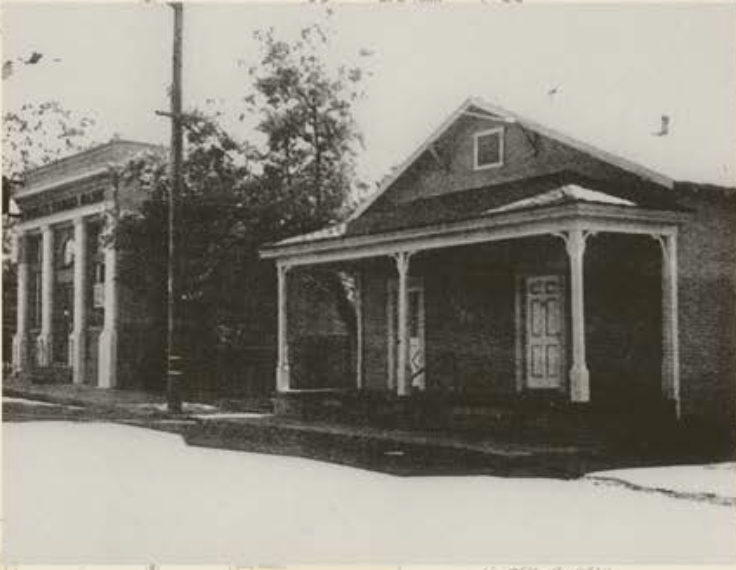
City Hall
9426 Main, Plymouth Ca
The 1890 Sanborn Fire Map shows this site as the Central Hotel. However no records exist to when City Hall was built. The hotel was built in 1882 by James and Emma Dingle who purchased the lot from Thomas Pinder an early Plymouth pioneer. James left in 1888 and Emma ran the hotel for a year selling it in 1889 to Robert and Anna Carroll. After the 1908 fire, George Noe’s saloon was located in the barroom of the Central Hotel.
Another fire July 1911 started in and destroyed the Central Hotel also damaging both the mortuary and the Ninnis Livery to the west.
The 1912 Sanborn Fire Map shows a small office and in 1930 a dance hall. In 1931 a fire destroyed the buildings across the street in what is now a park, including the original City Hall. City Council meetings were then moved to the dance hall.
Bill Sherwood, son of Judge Celia Sherwood, often played with his band in the dance hall. Many recall their childhoods sleeping on the hall’s benches as their parents danced the night away.
The first City Council elected in 1917 included James Park, Gariel Roos, C.H. Beasley, W.N. Taylor, and Lawrence Burke. W.J. Ninnis was appointed the City Marshall.
In 1975 the building was remodeled and is today’s city offices and council chambers.
Click video below for more information.
Speakers – Albert Miller & Ray Estey
Albert Miller grew up in Plymouth where his great
grandparents settled in the late 1800s. He maintained
the Plymouth Elementary School, drove generations of
Plymouth school kids to school, served on the city
council, the planning commission, the volunteer fire
Department and coached youth baseball and softball.
Ray Estey
Ray Estey is a lifelong resident whose family came to this area in the 1850s.


Miller Brothers Livery
9414 Main, Plymouth, CA
Jabez Ninnis first constructed a livery on this site in the 1870s. According to his great grandson, Gerry Ninnis, Jabez came from Plymouth, England. His wife’s name was California. The building burned down in 1877 but Ninnis rebuilt it. It was sold to William and John Miller who also owned a stable across the street. This building also became the stage stop.
The 1890 Sanborn Fire Map shows it as the Miller Brothers Livery. In 1912 it’s listed as the Plymouth Livery and in 1930 as the Plymouth Garage. The Ninnis family took over the livery business again and converted it into an auto repair garage.
After World War II, it became a car dealership. Johnny Moyle became the distributor for Kaiser-Frazier automobiles. They were sold on Main Street along with Packards. Johnny Moyle was also the mayor of Plymouth in 1946. Since then, the livery building has been owned and operated by Tommy Stayton, the Abercrombies and Rory Sheridan.
Click Video Below for more Information.
Speakers – Albert Miller & Jon Colburn
Albert Miller
Albert Miller grew up in Plymouth where his great
grandparents settled in the late 1800s. He maintained
the Plymouth Elementary School, drove generations of Plymouth school kids to school, served on the city
council, the planning commission, the volunteer fire
Department and coached youth baseball and softball.
Jon Colburn’s family came to the area in 1937. Jon was the youngest City Manager in the country having served in that capacity as a teenager at the
age of 19. He also served as a member of the Board of Supervisors and served on the Plymouth City Council.
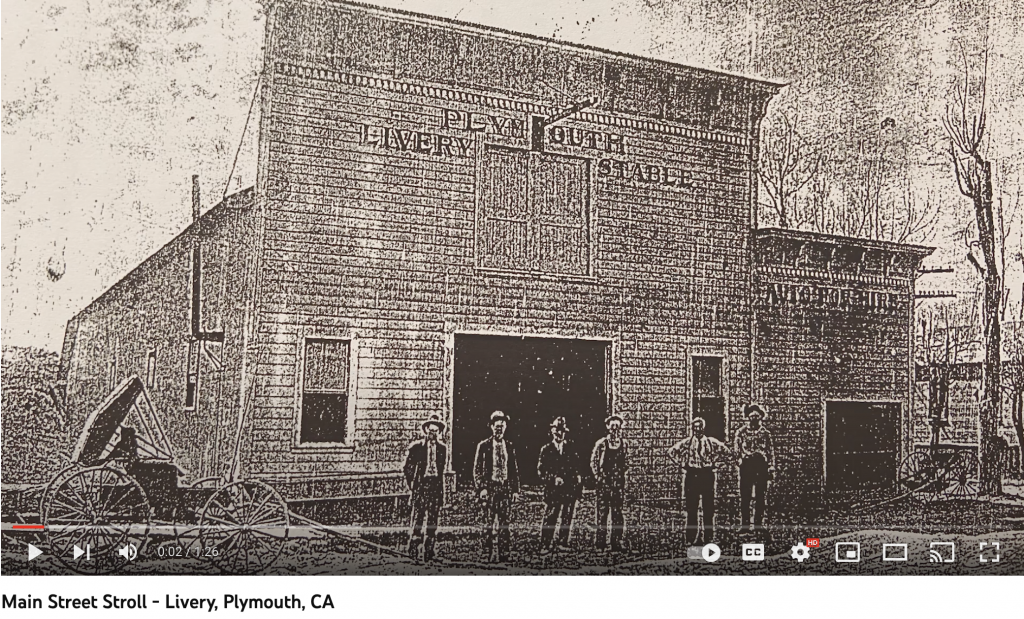
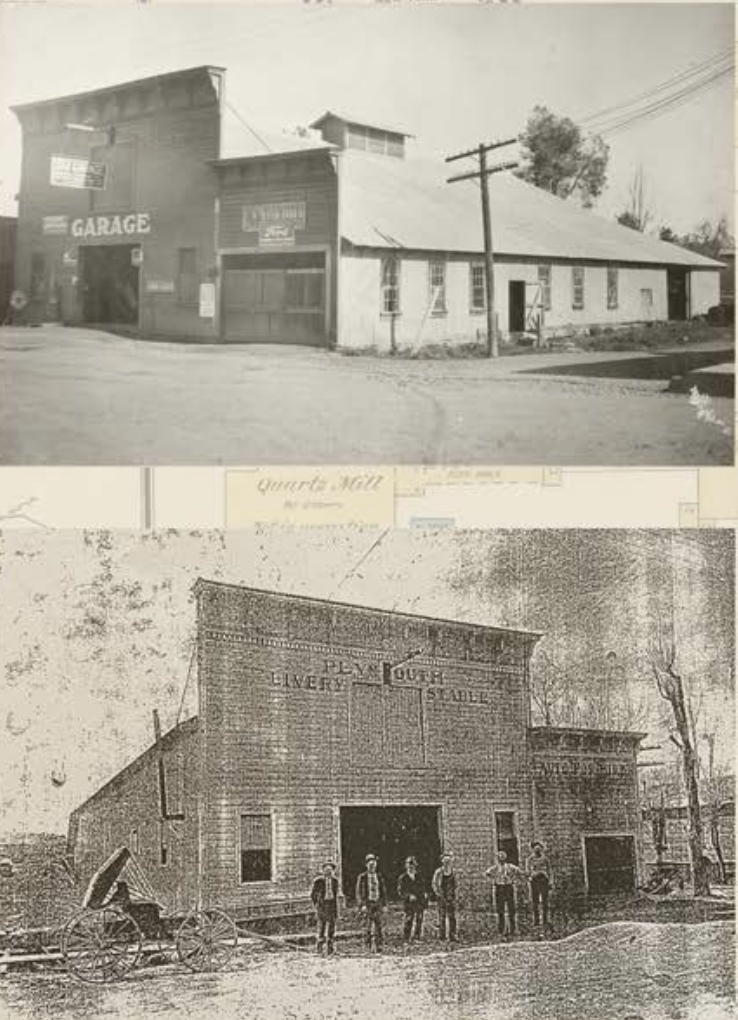
Arcade Bar/Sportsman Club
9402 Main, Plymouth, CA
This building was originally built about 1914 as the Arcade Bar.
During the days of prohibition, a soda fountain and candy store were in the front and a rumor was that a speakeasy was in the back . The 1930 Sanborn Fire Map lists the building as selling “soft drinks” as was the Pastime bar next door.
A story describes a time that two men got into a fight over a dice game although such games were not allowed there. The bartender, from a local family, “escorted” the offensive gentlemen to the street resulting in a fight. A gunshot ended the brawl and the bartender died in the street in front of his business.
The bar was also owned by Lester Lawerence and Leroy Pennington, son-in-law of the Leoni family, tended bar there. James Van Ausdale bought the place and called it Van’s Place. In the 1940s, Louis Hatchett and his brother Mervin bought the bar renaming it the Sportsman Club. When Louis passed away, his wife Nellie continued ownership. Louis’ brother Merv continued to operate bar with good humor. But by the 1980s, The Sportsman Club closed and fell into disrepair.
In the early 2000s, Mark and Tracey Berkner bought the place and renovated both it and the original mahogany bar. Today it is Taste restaurant.
Click Video Below for more Information.
Speaker – Ella Emerson
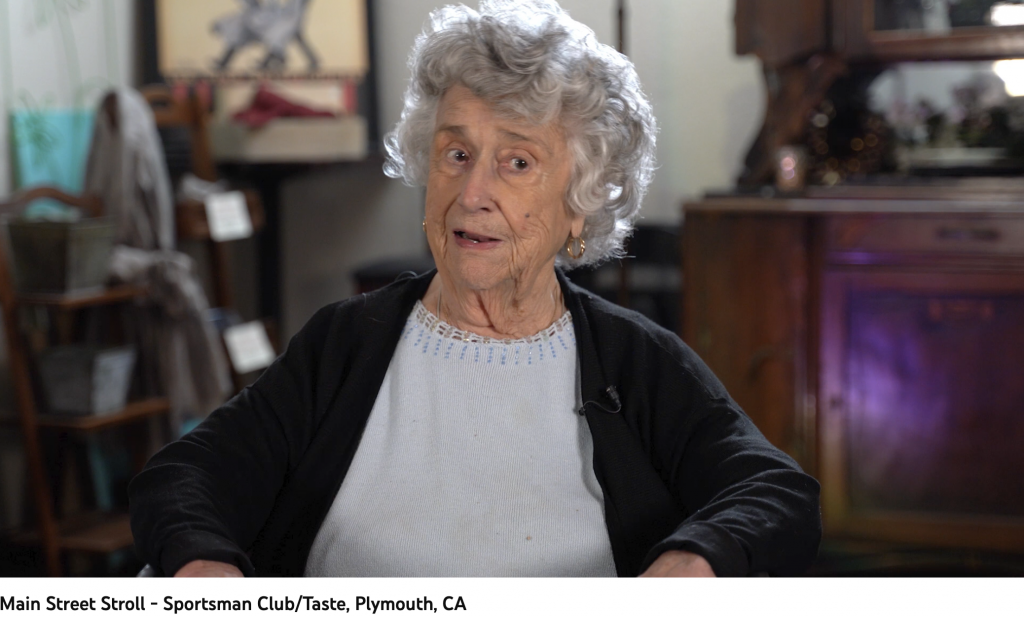

Pals Club/Pastime Club
9398 Main, Plymouth Ca
Joe Paz immigrated to the US in 1909 from Celigos, Spain, where he was born in 1892. Paz worked for the Southern Pacific Railroad then became a miner at the Plymouth Consolidated Gold Mines.
In the 1920s he opened his pool hall-club on Main Street. Joe married Teresa (née Barrena) and they had three children, Aurora, Elaida and Joe Jr. Joe’s brother Elmer and his wife Viola operated the bar for awhile.
The doors to the bar once had a painting of a cowboy and cowgirl that featured the duo Elmer and Viola. The painting was done by local artist Bunny Cofield but was painted over since. If you look very hard you may see traces of the painting. The bar was then leased to Vern Grelich who ran it for 20 years.
This piece of Plymouth history is still in the Paz family.
Click Video Below for more Information.
Speaker – Joanne Sturgeon



The Eliskovitch Building
9388 Main, Plymouth, CA
This building was the home of the Eliskovich barbershop. At one time there was a ladies hair salon next door. In the early days, this building was the telephone central office where party line stories once grew. The white fences on the side held the public telephones for many years before the advent of today’s smart phones.
Click Video Below for more Information.
Speaker Dan Eliskovitch
Dan is the son the barber Eliskovitch and grew up in
Plymouth and the barber shop and still has one of the
Barber chairs.
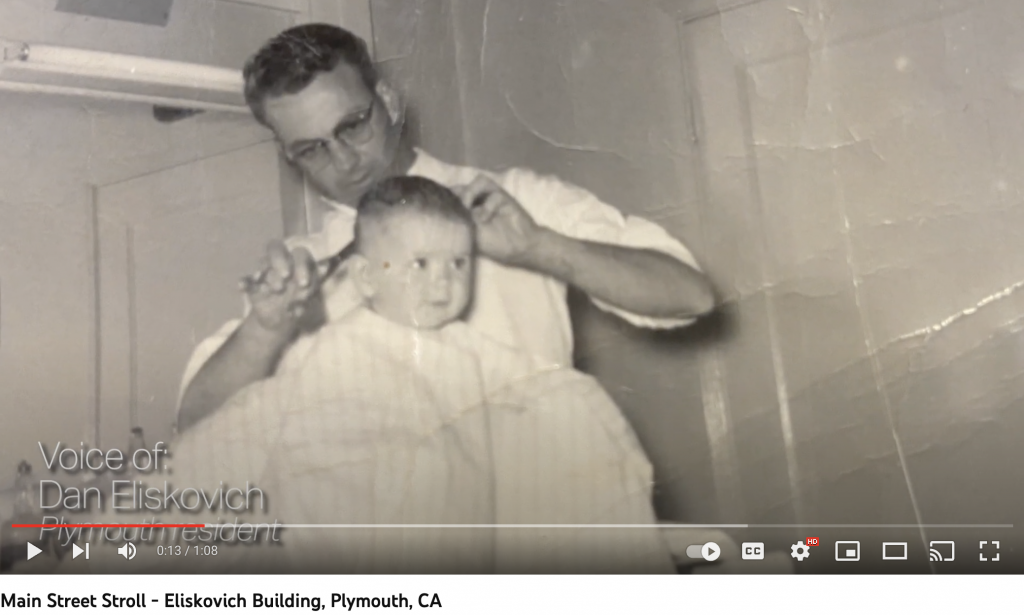
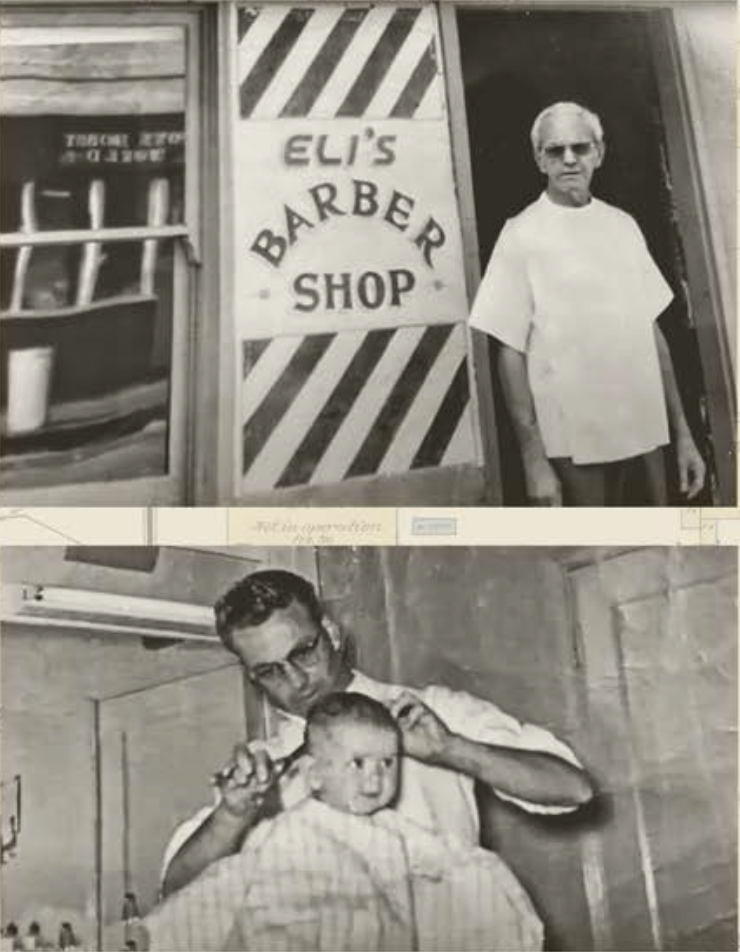
The Theater
9372 Main, Plymouth CA
This building that is now Rest Hotel was originally a “Gentlemen’s Saloon” in 1880. In the early 1900s it was converted into a movie theater and is listed on the 1930 Sanborn Fire Map as a theater. Virginia Leoni Pennington played piano here during the silent film era. Mrs. Wheeler may have been her piano teacher. Celia Sherwood also played piano in the theater and later became an Amador County judge.
Joanne Sturgeon who grew up in Plymouth recalls as a little girl setting up her Kool-Aid stand by the ticket booth after movies were no longer being shown. Plymouth’s Constable Elmer Jacka who was known more informally as “Buckshot,” quickly escorted her off the premises.
The Avilas who owned both the theater and Rose’s Restaurant next door converted both into apartments.
Click Video Below for more Information.
Speaker – Tracey Berkner
Tracey and her husband Mark run Taste and Rest and
are dedicated to the revitalization of Plymouth.


Rose’s Café
9372 Main, Plymouth, CA
Rose’s Café was run by Rose Avila in the 1950s and 1960s and was quite popular in Amador County. Some came for the tacos, others the Spanish rice and beans and others the enchiladas–everyone came for the small town atmosphere. Rose Moreno whose family operated the Plymouth Hotel, worked here. Prior to Rose’s the building was Skagg’s restaurant.
The 1890 Sanborn Fire Map shows the building as a general store and the 1912 map as a boarding house. In the 1930 map, it was listed as vacant.
The Avilas converted the restaurant and the theater next door into apartments.
For more information click on video below.
Speaker – Jess Avila
Jess Avila is the son of Rose and grew up in Plymouth
and around the cafe
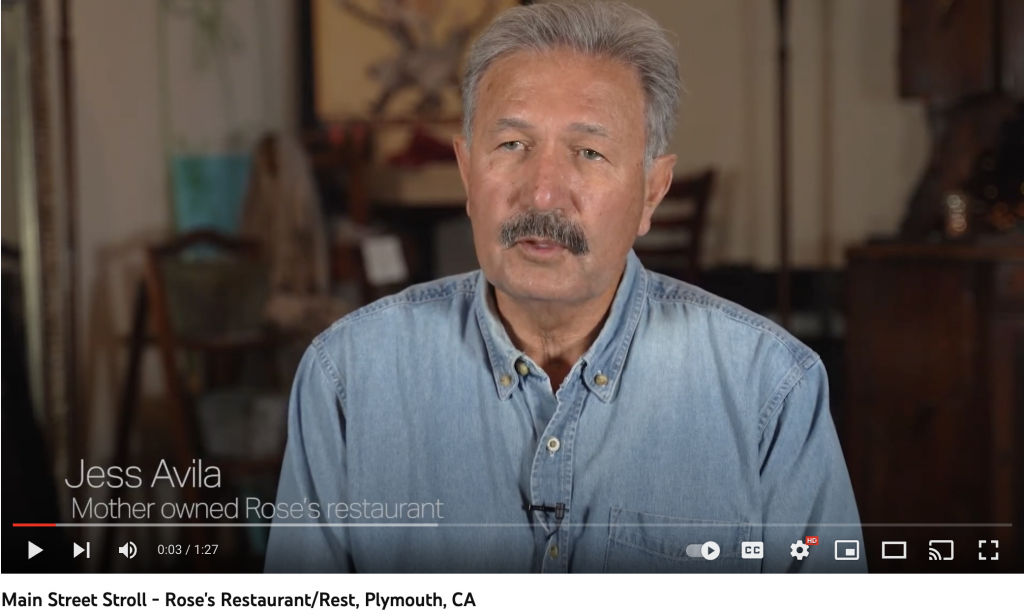
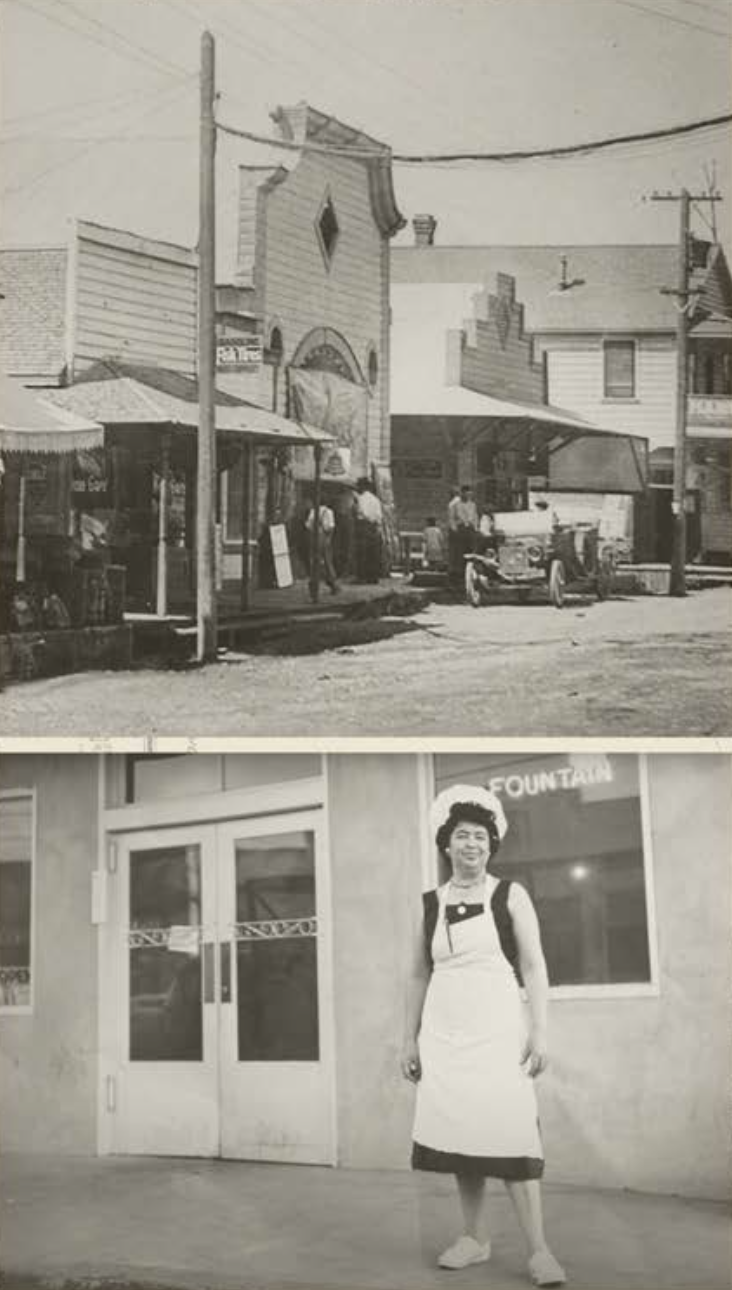
Harvey Hotel/The New Plymouth Hotel
9356 Main, Plymouth, Ca
The original Harvey Hotel was built in 1881 by William Harvey who emigrated from Liskeard, England, at the age of 39. After his death in 1882, His widow Charlotte ran the hotel for over 40 years. When the fire of 1908 destroyed most of the buildings on the opposite side of the street, C. Devore opened up a saloon and barbershop inside the Harvey Hotel.
John Moreno bought the hotel in 1930 and remodeled it covering it with plaster. He designed it to resemble the original Plymouth Hotel, stage stop and office, that he operated on the north side of Main Street. When that Plymouth Hotel was destroyed by fire on Sept. 10, 1931, He renamed it the Plymouth Hotel. This new hotel had a bar serving soft drinks during prohibition, a restaurant, pool table and slot machines. The remodeled Plymouth Hotel here stands today.
When Mr. Moreno died in 1934 at the age of 36 from miners’ consumption (tuberculosis), his widow Rose continued to operate the hotel, bar and restaurant until it was purchased and run by Pete and Lucy Urjevich.
During remodeling local residents noted that steel reinforcement in the walls was made from old bed springs!
The current owner purchased the hotel in the 1990s and currently resides here. Plymouth Hotel had a bar which served soft drinks during prohibition, a restaurant, pool table as well as slot machines. The remodeled Hotel stands today.
For more information click on video below.
Speaker – Ella Emerson
Ella was the daughter of Rose and John Moreno (Spanish Immigrants) who restored the Plymouth Hotel. Ella was born in the original Plymouth Hotel across the street and said that after her birth her mother prepared lunch for the boarders.
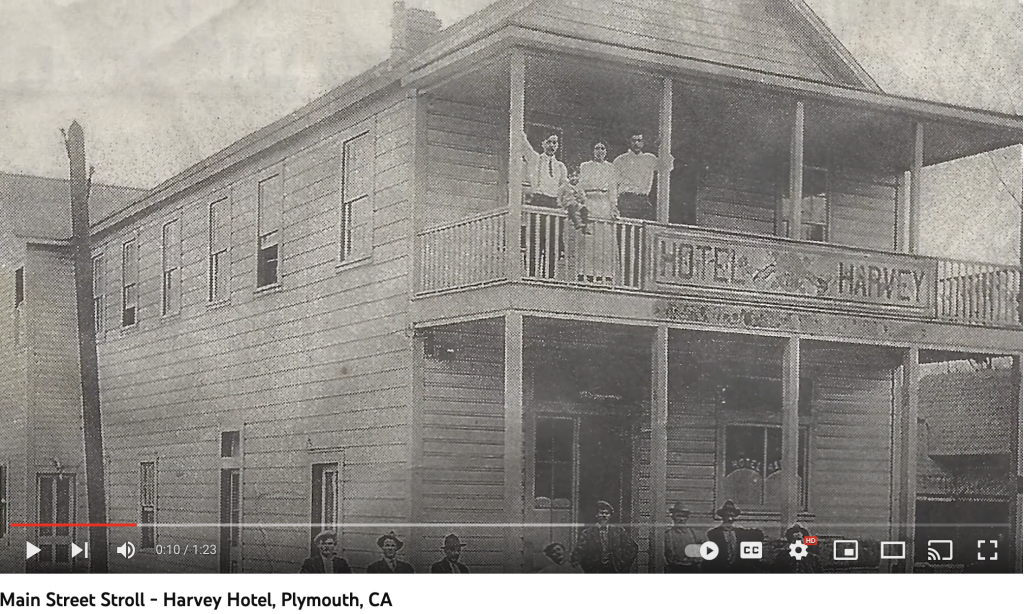
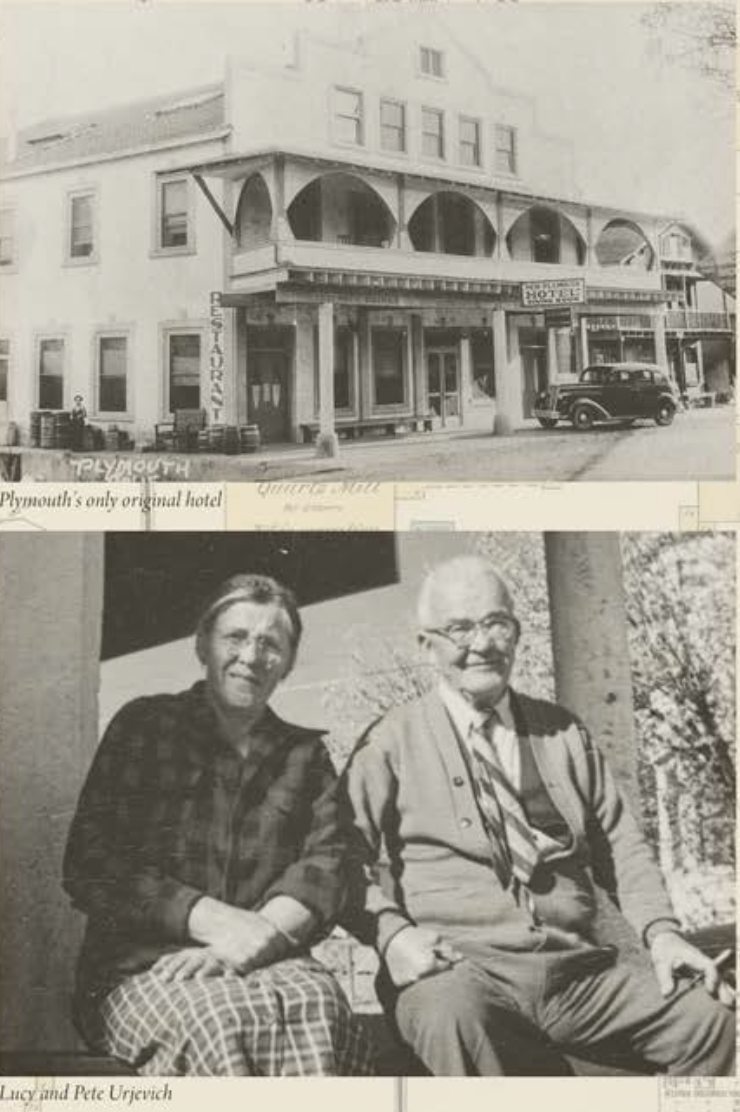
Colburn house
9359 Main, Plymouth, Ca
The original saltbox-style house was built in 1878 by the Caucasian Society, a group opposed to the Chinese working in mines since they labored so hard surpassing the toil of the “Caucasians.”
It originally had a lodge hall on the second floor and a general store on the bottom. Later a mortuary and clothier occupied the bottom. The 1890 Sanborn Fire Map lists a tailor and “Meat Hall” which is assumed to mean meeting hall. The meeting hall was on the second floor. An 1884 article in the Amador Ledger narrates that there was an argument between the tailor and a customer over the payment for clothing. The customer, Peter Shaparal, challenged the tailor B. Vegia to a duel leaving Mr. Shaparal dead in the street. Mr. Vegia was tried but was not convicted.
The house was remodeled into the current Victorian- style building by Plymouth pioneer and businessman B. Levaggi who bought it 1899. Later it became the offices of the Plymouth Consolidated Mining company.
In the mid 1930s it was purchased by Harold and Marie Colburn and became their family home and is still owned by family members today.
Speaker – Jon Colburn
Jon Colburn’s family came to the area in 1937. Jon was the youngest City Manager in the county having served in that capacity as a teenager at the age of 19. He also served as a member of the Board of Supervisors and served on the Plymouth City Council.


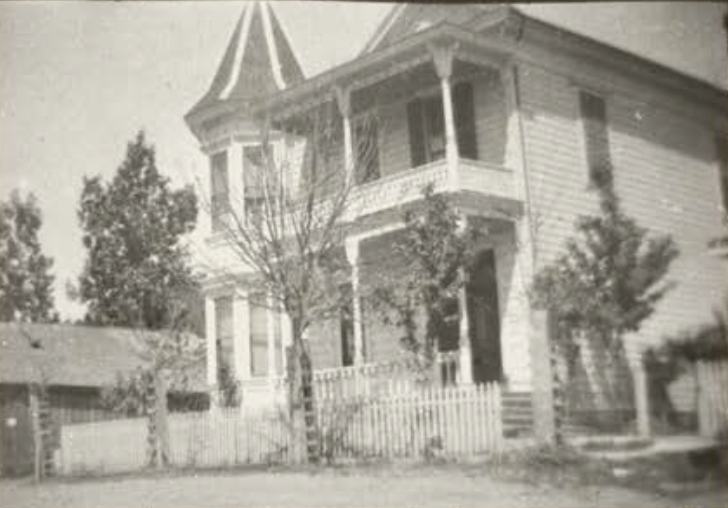
Colburn Drugstore
9369 Main, Plymouth, CA
This building was built c.1890 and on the Sanborn Fire Map is listed as a “Variety.” On the 1930 Sanborn map it is noted as a “Notions and Drugs” store. The building was once the Foley Drug Store. Harold Colburn purchased the building. He also owned a drugstore in Ione.
Mr. Colburn was proud of the title “Founder of the Amador County Fair” and brought the fair to Plymouth in 1938. He was a founder of the Amador County Water Agency and on the board of directors from 1966 to 1986. He was a also a county supervisor and a candidate for Lt. Governor in the 1950s.
This building had a pharmacy and a soda fountain. Mr. Quisenberry was the pharmacist and “soda jerk.” Next door was Mrs. Barton’s Ice Cream shop.
Mr. Quisenberry is fondly remembered by older members of the community who were able to sit at the fountain and read comic books without having to pay. Marie Colburn is also remembered for keeping the candy counter well organized with the candies arranged from the least to most expensive.
Today this is the Plymouth City Library.
Speaker – Marilyn Seratte
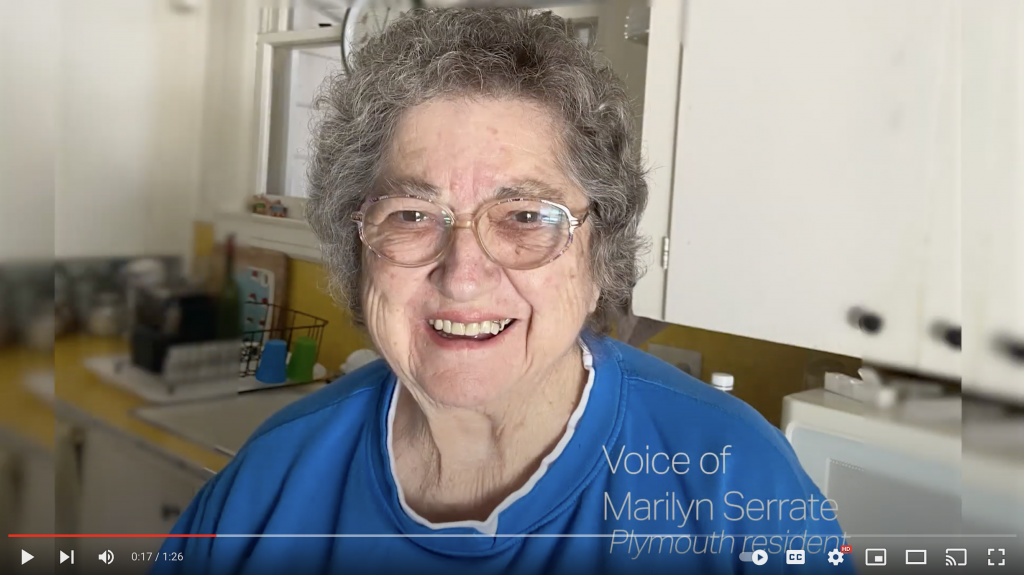
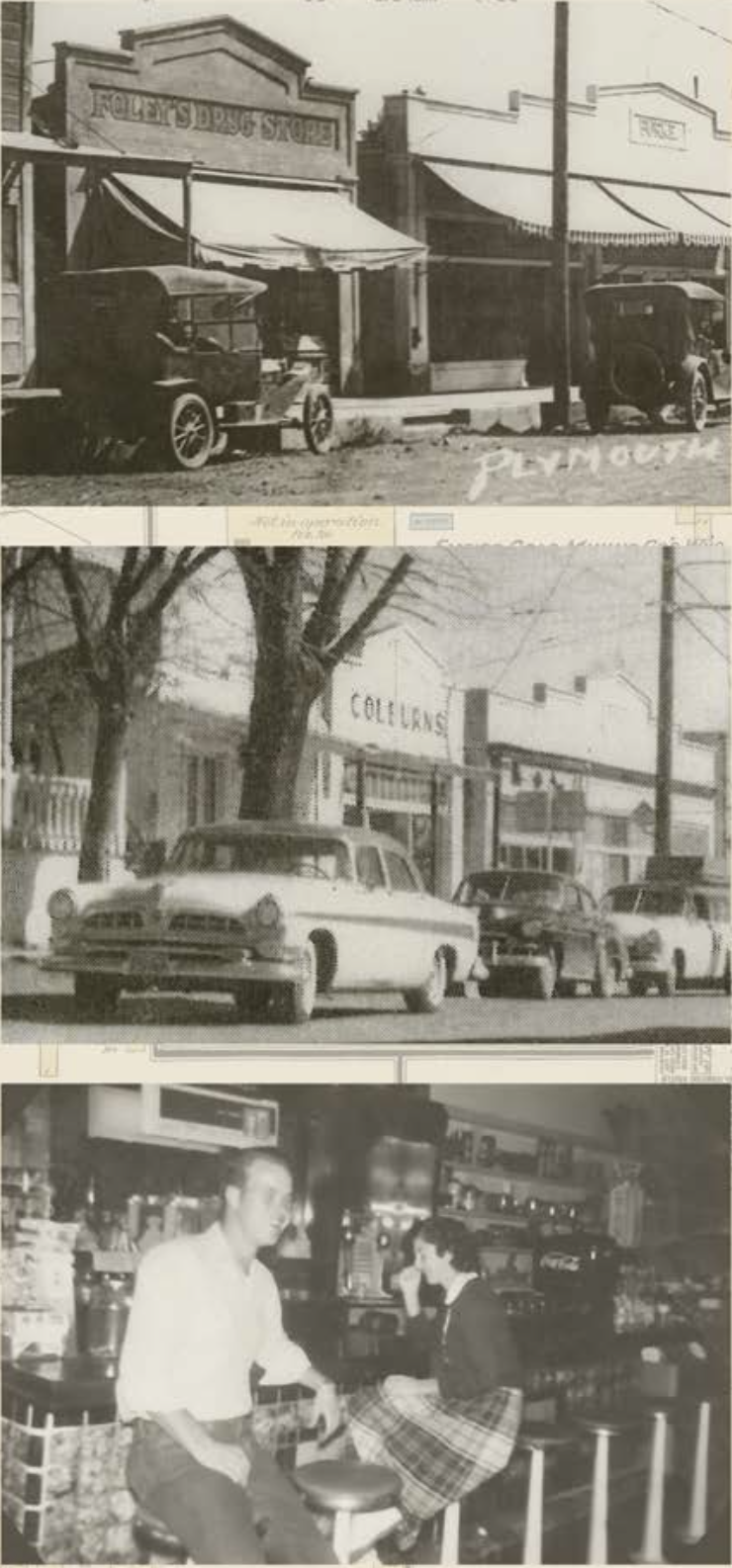
The Burke Building
9383, 9379, 9375 Main, Plymouth CA
While it is unknown when the Burke Building was built, an 1889 article in the Amador Ledger mentions that Mr. Levaggi expanded the building for more space for his General Store. The fire of 1908 burned nine buildings on the north side of Main Street and one was Lawarence Burke’s retail meat market. Burke was very active in the community serving as a city board member, a business man and a land owner. His land included a slaughterhouse east of town on what is now known as the Burke Ranch. Instead of rebuilding his meat market after the fire, Mr. Burke bought the the building from Mr. Levaggi and reopened the meat market sharing the space with a granary. The building was later expanded to include the three store fronts as you see today.
Mr. Burke lived just to the west and next to the current Masonic Lodge. Local residents tell stories of Mrs. Burke sending their St.Bernard dog down to the Wheeler market with a note tied to his neck and returning with a pound of hamburger in a basket also tied around his neck.
Speaker – Audrey Crain Sousa



Plymouth City Park & Plymouth Hotels
9431, 9435 Main, Plymouth CA
Plymouth City Park and adjacent lots were the site of many of the Plymouth hotels–all of which burned. The 1890 Sanborn Fire Map shows the Commercial Hotel which became the McGee Hotel according to an 1887 newpaper article listing Mrs. McGee as proprietor. It may also have been called the Pokerville Hotel. In 1928 William McGee donated this parcel to the City of Plymouth in memory of his parents who ran the hotel.
Samuel and Ella Adams bought the McGee Hotel and renamed it the Adams Hotel. The Phillips skating rink was in the back. Ella was a graduate of Mills College and a charter member of the Native Daughters of the Golden West, Forrest Parlor #86. Mrs. Adams was appointed Post Master after her father Post Master Dr. Duncan died. The fire of 1908 started in the Adams Hotel destroying it and nearby buildings.
Ella Adams rebuilt the hotel east of the park which is now Plymouth Plaza. The Adams Hotel was where Will Rogers filmed Doubling for Romeo in 1921.
The original Plymouth Hotel was next to Milos “Sharkey” Begovich playground and park. Before it was the Devore Hotel and a second story was added. The Plymouth Hotel was run by John Moreno starting in 1928 when C. Prato was the owner. It was a stage coach stop and office. W. Speakman’s Barbershop was here for 45 years. Mr. Moreno purchased the Harvey Hotel across the street in 1930. He remodeled it to resemble the original Plymouth Hotel that he also ran. On September 1, 1931, a fire started in the flue of the Adams Hotel, destroying it along with the original Plymouth Hotel, City Hall, Plymouth Volunteer Fire Department and the Alpine Garage which had been the former buggy shop.
Speaker – Ray Estey
Ray Estey is a life long resident of Amador County. His family came here in
the 1850s.

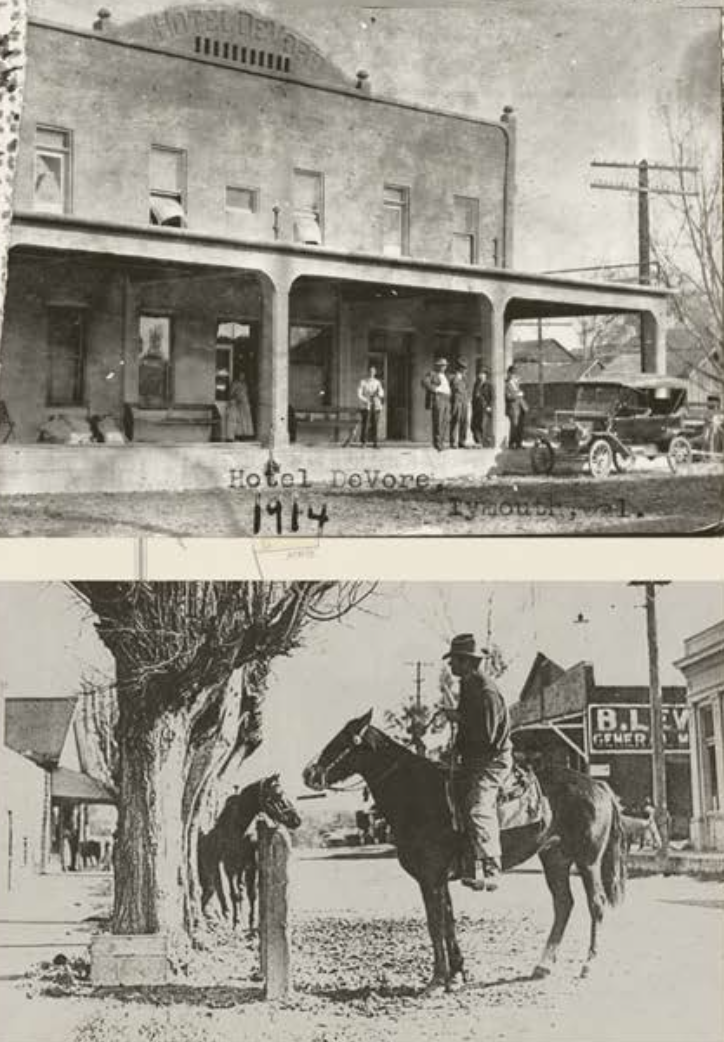
Plymouth Volunteer Fire Department
The City of Plymouth has a rich history of service by its Volunteer Fire Department. Its first was the Plymouth Hook and Ladder Company which held the Firemen’s Ball in the Caucasian Hall in 1872. The Sanborn Fire Map of 1912 mentions that the fire department is a “volunteer co. (not organized) aparatus: 500´ 2-½´´ hose–cotton rubber–on hose cart.”
Plymouth incorporated in 1917 and in 1927 the City bought a 1927 Chevrolet cab and chassis truck. The tank and pump were installed at the Sutter Creek High School under the watch of shop instructor, Mr. Landrum. It remained in service until the 1960s. Plymouth’s fire department was all about community fundraising with continual involvement of the families of its volunteers. The department continued to buy additional and some smaller equipment which allowed faster response to emergencies and reduced wear and tear on the older and larger fire engines.
The fire station on Main Street was built on private property with the provision it could remain there as long as it was the original building. Fire destroyed this building in 1931. The front was open and often times the batteries were dead or gas tanks were emptied. Kittens would have to be shaken out of the turnout jackets before donning them. The west wall was was collapsing. There was a fire bell and siren located on the hill behind today’s City Hall. The code to activate the alarm was a four-letter word which could be easily dialed on the phone at City Hall. Local kids did this often. The fire house moved to its current location on Sherwood Street about 1984.
Speaker – Antonio Moreno
Antonio Moreno was the Volunteer Fire Chief for the City of Plymouth. His family dates back to the early 1900s.
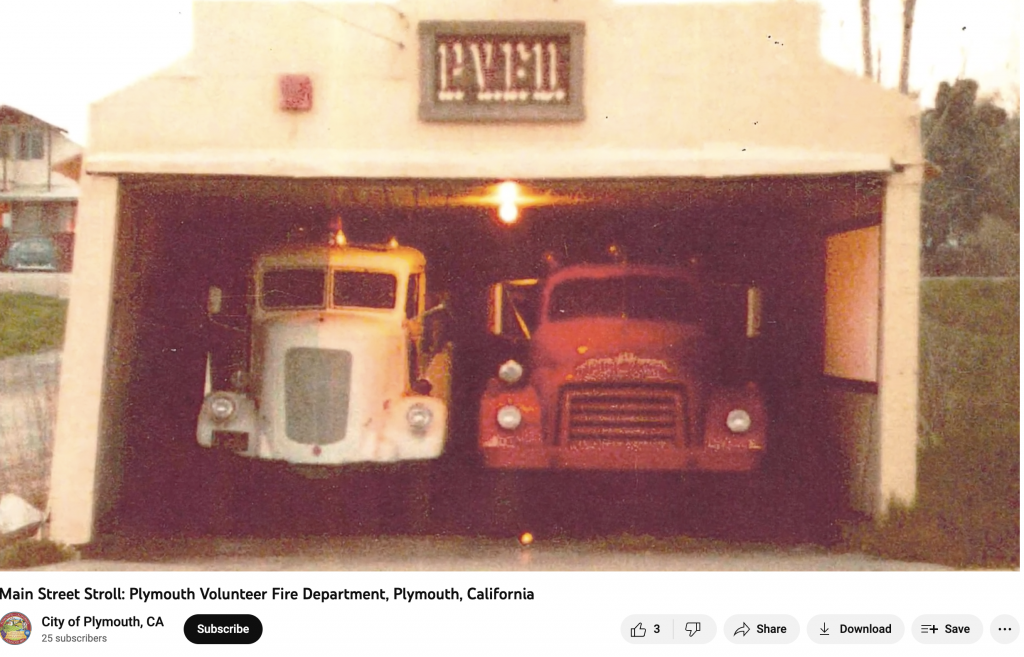
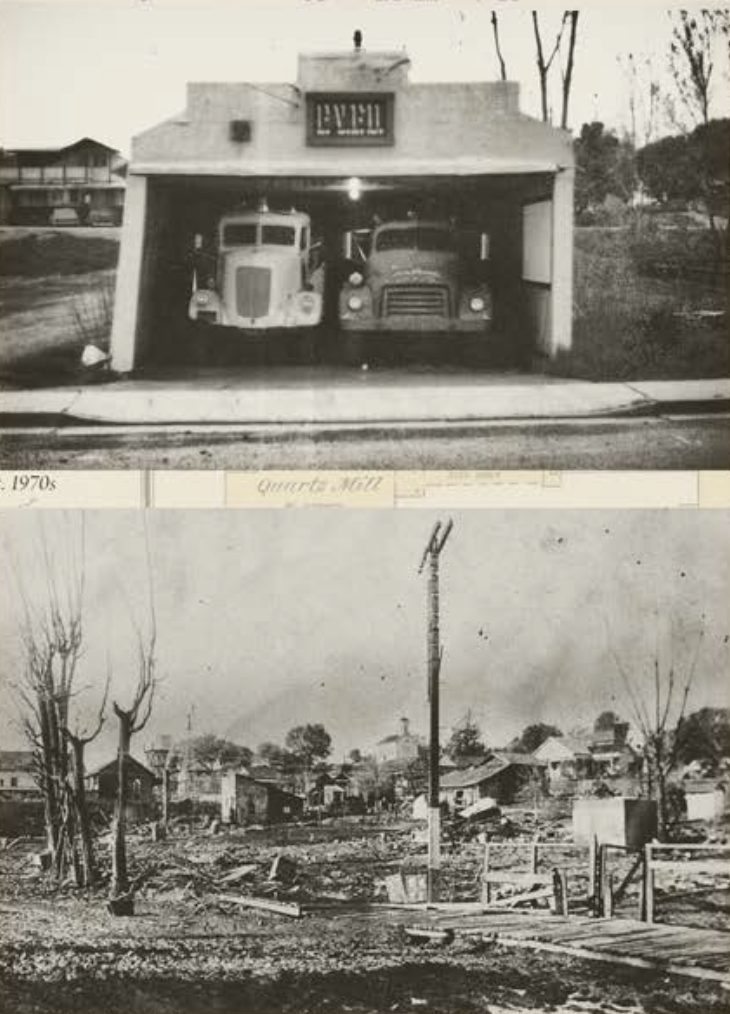
Studebaker Quality Grocery
9451 Main, Plymouth, CA
Listed as a vegetable market on the 1930 Sanborn Fire Map, this store was run by Telio Traverso known simply as Telios. In 1947, Mary and Gordon Studebaker ran the Studebaker Quality Grocery Store until late the late 1950s. Then it was owned by Elsworth Miller. The Studebaker’s store was one of three grocery stores in Plymouth. Popular with men working in the timber industry, they could call in the middle of the night to get gas, ice and other supplies from this one store. The Studebakers left the area for a short time and upon their return ran the Studebaker Quality Grocery Store in the Wheeler Building nearby.
The Studebakers sold the store to Eunice and James Parr in 1958 who later sold it to Mary and Gene Brown. The Parrs and Browns continued to run the store as a grocery.
Speaker – Diane Studebaker Matich
Diane grew up in Plymouth and still resides here as do her sisters, Kathy and Phyllis. They are the daughters of the Studebakers.
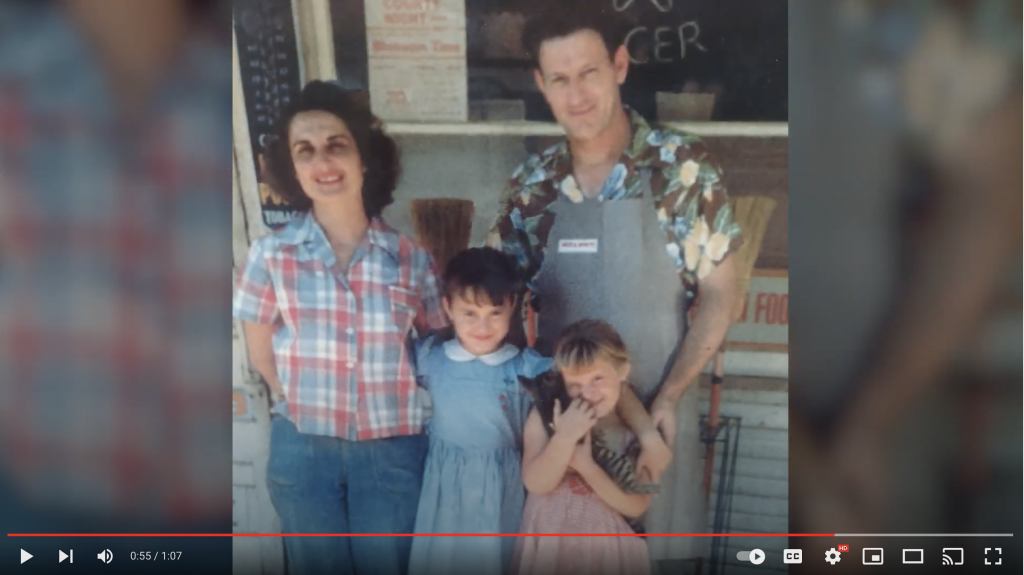

The Wheeler Building
9393 Main, Plymouth, CA
The Wheelers were pioneers in Plymouth and miners of the original Alpine Mine which was behind the store and the park. The Sanborn Fire Maps of 1880 and 1890 shows the site as a candy store. This building was built around 1924 by Lester Wheeler,grandson of Stephen Wheeler the original founder of the Alpine Mine.
The Wheelers first had their store across the street and then moved to this location. The building was originally wooden and Lester replaced the original building and saloon with this brick building in 1938. That same year, Lester served on the first Board of Directors of the Amador County Fair which had just been established in Plymouth.
The building today has the original wooden floors and wooden posts. The building housed the Wheeler Store and later the Studebaker Quality Market and eventually became office space.
Speaker – Susan Wheeler Neff
Susan Wheeler Neff is the granddaughter of Lester A.Wheeler and grand
niece of Vern Wheeler, Lester’s. brother Mark Wheeler is the grand son of
Lester and grand nephew of Vern. The Wheelers started the Alpine Mine.
Mark and Susan own the building
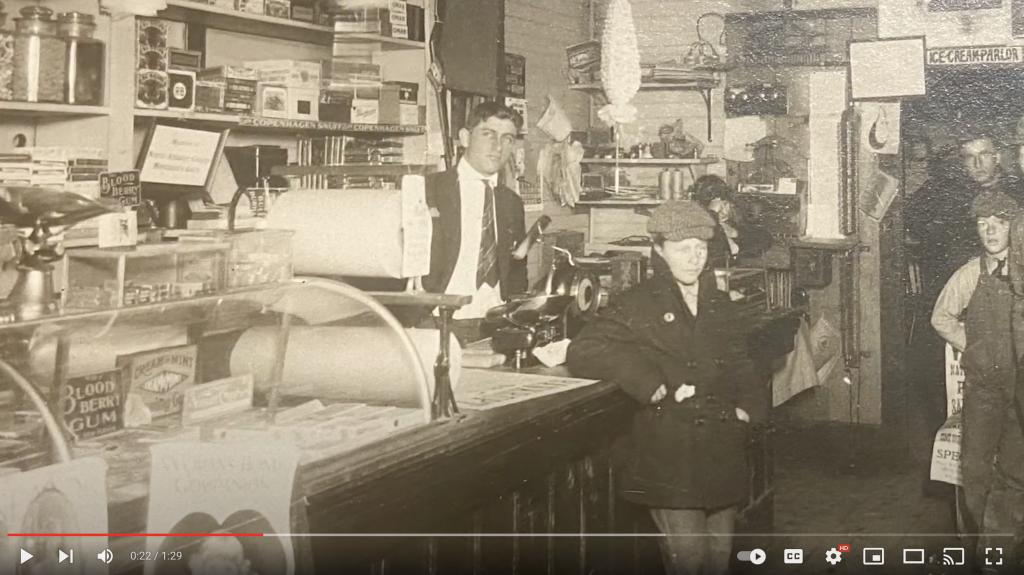
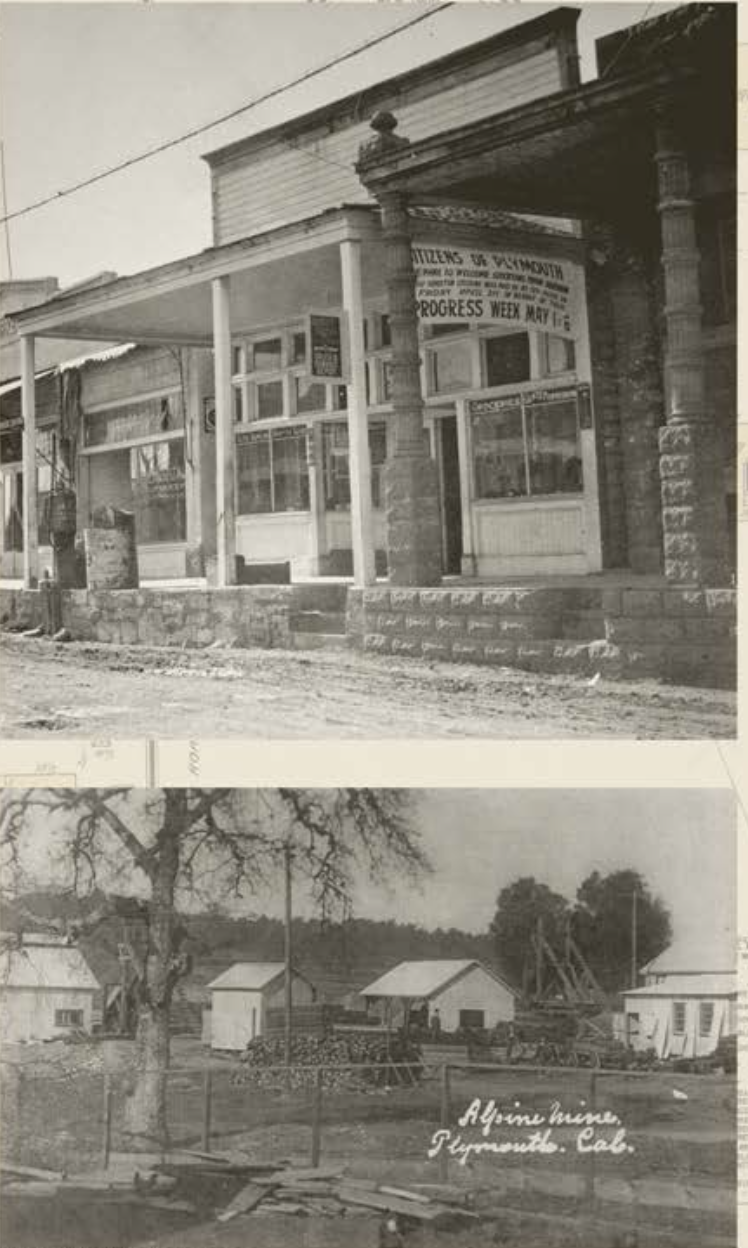
The Leoni House
9511 Main, Plymouth CA
This house was built in 1915 by Herman Leoni a Swiss immigrant who married Flora Matulich in 1913. Herman built the house with his wife’s brother.
Herman ran the blacksmith shop on Main Street where the Post Office is today. The blacksmith shop was damaged in the Plymouth fire of 1911 but remained open for many more years Later area shepherds would bring their flocks to the barn for shearing.
Herman and Flora’s daughter Virginia Leoni was born in Drytown at the Matulich ranch and raised in this house eventually graduating from Sutter Creek Union High School. Virginia was an artist and played piano during the silent moves shown at the Plymouth theater.
Virginia’s husband, Leroy Pennington, a descendent of Calaveras County pioneers, tended bar part time at the Sportsmans Club down the street. The Leoni house is now owned by Meredith Campbell, great granddaugher of Herman Leoni, along with her husband Jon, who ironically, grew up next door.
Speaker – Meredith Cambpell
Meredith Leoni Campbell is the great granddaughter of Herman Leoni who
owned and ran a blacksmith shop at the site. Heman is the son of Stefano
Leoni who came to California in 1848 from Switzerland. He operated a
ranch and creamery in Grizzly Flats. He and his wife, Theresa lived their
retired years in this house – five generations of Leonis have lived in this
house. The Leonis are buried in the Plymouth City Cemetery. The houme is
still in the Leoni family.
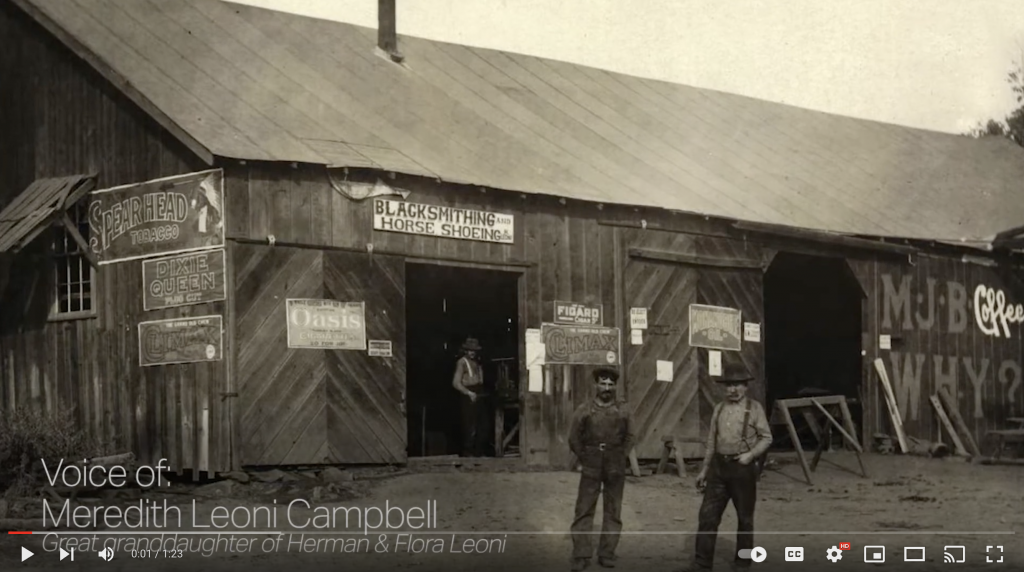
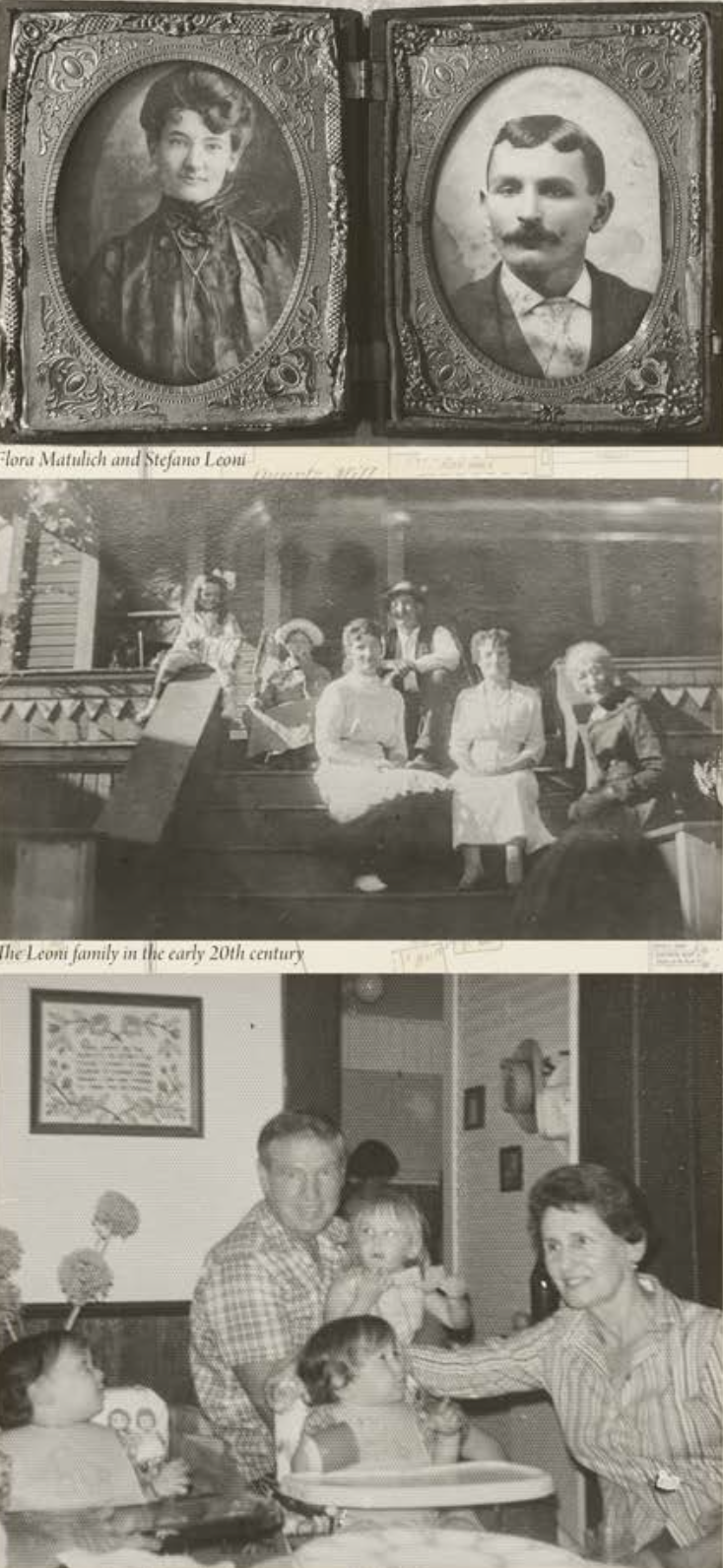
The Plymouth Inn
9525 Main, Plymouth Ca
This beautiful Victorian style home was built about 1870 and was operated as a boarding house by two Italian immigrant brothers, Gazato and Bartolomew Gazzola. The earlist county assessor records of 1880 show the owner as Gazzola.
Dr. E.V. Tiffany lived in the home in the early 1900s and his medical office was across the street in the Forrest House Hotel. Dr. Tiffany and his wife moved to Oakland in 1907. The home has changed owners over the past century and was the home of the Goodall family in the 1950s. The home is now a bed and breakfast inn owned by Ms. Sandra Sanders.
Speaker – Don Goodall
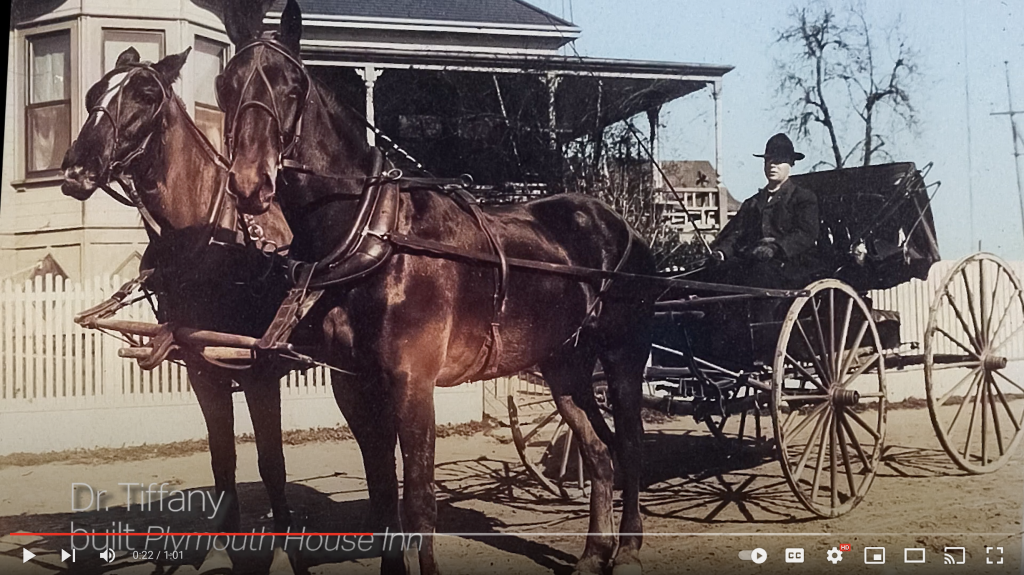

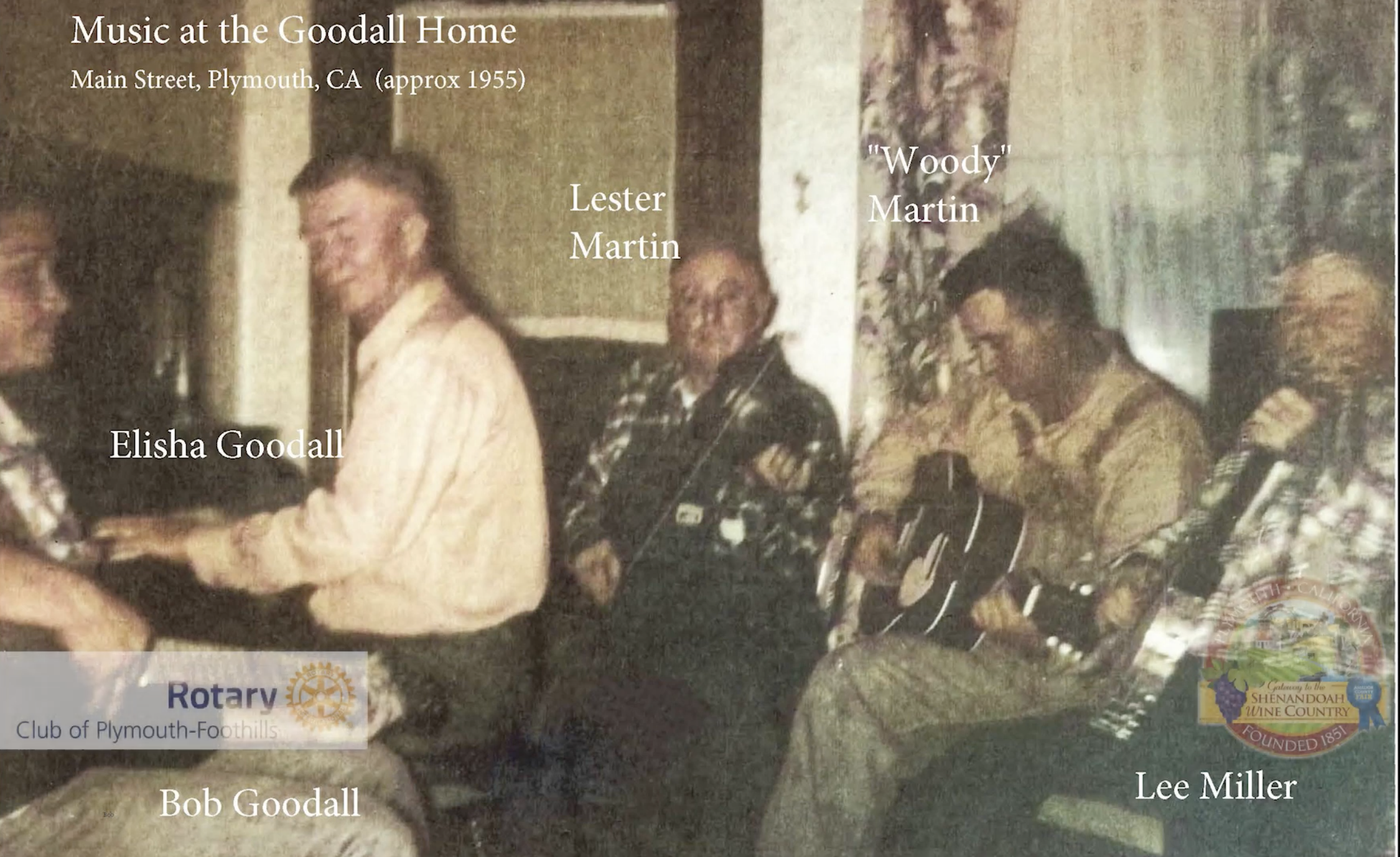
Also Know n as The Historic Plymouth House
9525 Main
Speaker – Darrick Baird
Darrick was raised in the Historic Plymouth House and spent much of his childhood there. He is the son of Sandy Sanders who has owned the building since the early 1970s. She still lives here and cares for the historic house.
Play Video below for more history.



